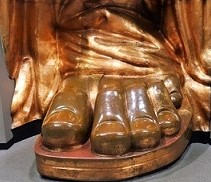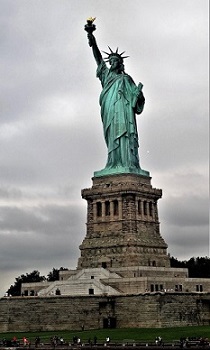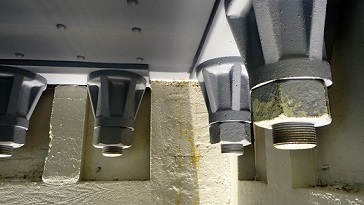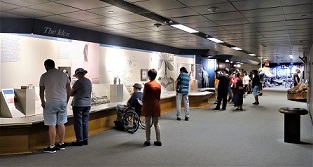


|
|
|
|||||||||||||||
|
|
||||||||||||||||
|
|
||||
|
|
New York Statue of Liberty
The Statue of Liberty stands on Liberty Island at the entrance to New York Harbour. The Statue was a gift of friendship from the people of France to the people of the United States. Liberty Island was originally known as Bedloe's Island, but in 1956 it was renamed Liberty Island by a joint resolution of Congress and signed into law by President Dwight D. Eisenhower. The idea for the Statue was conceived in 1865 during a conversation between two Frenchmen, Édouard René de Laboulaye, a staunch slavery abolitionist, and Frédéric Bartholdi, a sculptor. The idea was to honour the Union victory in the American Civil War and to help strengthen the relationship between France and the United States. However, due to the political situation in France at that time, the project was put on hold for ten years. Ultimately, funds were raised from small individual contributions from the French populace rather than from their government. Construction on the statue began in France in September 1875, with the arm holding the torch being the first part completed in 1876, this was then shown at the Centennial Exhibition in Philadelphia. Two years later in 1878, the head and shoulders were completed, and this was displayed at the Paris World Fair. Construction of the body of the Statue was completed in 1884. The method of construction began with the fabrication of wooden frames for each section of the figure. These frames were then plastered to produce an exact replica of the final version of each full-sized piece. Next, copper sheets were placed over each mould and hammered into its shape - a process called repoussé. Approximately 80 tons of quarter inch-thick copper sheeting were used for this. This process of hammering reduced the copper to about 3/32nds of an inch thick. When they had obtained the desired shape, they were removed from the mould, numbered and catalogued which resulted in the production  Although the Statue was to be built and presented by the French, the pedestal on which it was to stand was to be constructed and paid for by the Americans. The New York committee commissioned Richard Morris Hunt to design it in 1881. Within months, he submitted a detailed plan, and informed the committee that he expected construction to take about nine months. Hunt proposed a pedestal 114 feet (35 metres) in height but, due to limited financing, the committee reduced that to 89 feet (27 metres). Hunt’s design was to contain elements of classical architecture, with Doric portals, as well as some elements influenced by Aztec architecture. The construction on the 15 feet (4.6 metres) deep foundation began in 1883, under the directorship of former Army General Charles Pomeroy Stone, who was to oversee the construction work. The pedestal's cornerstone was laid the following year. The pedestal was aligned so that the statue would face southeast, greeting ships entering the harbour from the Atlantic Ocean. Hunt's original design was to make the pedestal out of solid granite although, once again, financial restraints required him to revise his plans. The final design called for poured concrete walls up to 20 feet (6.1 metres) thick, which was the largest pour of concrete up to that time. The walls were then faced with granite blocks brought from Connecticut. The shape of the pedestal is in the form of a truncated pyramid, 62 feet (19 metres) square at the base and 39.4 feet (12 metres) at the top. The four sides are of identical appearance.  Above the door on each side were placed ten disks, where it was proposed to place the coat-of-arms of each of the States (between 1876 and 1889, there were 38 U.S. states), although this was never done. Above those, near the top of the pedestal on each side, was a balcony to be used as an observation platform, which was framed by pillars, and above this, the statue itself rises. The pedestal sits on top of the remains of a wooden fort, originally a link in a chain of defences protecting New York and its harbour. The fort was built between 1808 and 1811 in the shape of an eleven-pointed star. In 1883, the pedestal was erected inside the fort, transforming its star-shaped base into the Statue’s perimeter structure. In 1907, improvements were made integrating Fort Wood’s structure into the path of entry into the statue, resulting in the space being levelled and paved. The space between the pedestal and rampart was excavated in the 1960s and enclosed to form the museum, and in 2011 the fill was removed to expose the remains of the fort. The room that can be seen today is most likely dating back to 1840 and is a bomb-proof room used as a guardroom and later as a prison cell.  Once the pedestal was completed, the task of reassembling the Statue began. The Statue itself had been assembled in Paris where it was displayed, then disassembled in 1885 and shipped to the United States aboard the French Navy ship the Isère. This entailed it being reduced to 350 individual pieces and packed in 214 crates. It arrived in New York Harbour on June 17th, 1885 to great fanfare and was placed in storage while the pedestal was constructed. The original design was to have a masonry pier to support the copper skin, but the designer, Eugene Viollet-le-Duc, died in 1879 leaving no indication of how he intended to connect the copper skin to the pier. He was replaced by the innovative designer and builder, Gustave Eiffel, who changed the support of the Statue by placing it around an iron truss pylon. This provided the advantages of better accommodating movement and stress. A secondary skeleton was attached to the central pylon to enable the statue to move slightly in the wind. The change in design also meant that the load (the weight of the structure plus any imposed loadings such as rain, snow or wind) is supported by the interior framework, not the exterior skin. In addition, this metal frame allowed the incorporation of two internal spiral stairways, which provide access to the top of the Statue.  Once this was done, the sections of skin could be attached. To accommodate the expansion of the metal, the skin was loosely connected to the frame with flat iron bars which incorporated a mesh of metal straps, known as "saddles", that were riveted to the skin, providing firm support. The skin consisted of two layers which were separated by a thin layer of asbestos impregnated with shellac to prevent corrosion. To assemble them, the pieces were placed in position and then soldered and riveted together. This can be seen clearly on a trip up the statue, as can the folds of the copper sheeting. Due to the width of the pedestal, it was not possible to erect scaffolding, and workers dangled from ropes while installing the skin sections. Once completed, the total overall height from the base of the pedestal foundation to the tip of the torch was 305 feet, 6 inches (93 metres). The height of the Statue from head to heel is 111 feet, 6 inches (34 metres). The total weight is 225 tons (450,000 pounds).  The face on the Statue of Liberty measures more than 8 feet (2.4 metres) tall and a replica, in its original copper colour, can be seen in the museum. The museum contains the complete story of how the statue came to built and includes many items explaining and illustrating the processes of how this was carried out.  The official dedication of the Statue of Liberty presided over by President Grover Cleveland, took place on October 28th, 1886. Originally the statue was a dull copper colour but, by 1900, a green patina caused by the oxidation of the copper skin began to form, and by 1906 it had entirely covered the statue. Believing that this was evidence of corrosion, Congress authorized $62,800 to paint the Statue both inside and out. The prospect of painting the exterior resulted in considerable public protest, and a study carried out by the Army Corps of Engineers found that the patina actually protected the skin. As a result, only the interior was painted. It was at this time that the Engineers installed an elevator to take visitors from the base to the top of the pedestal. The torch that the Statue currently holds was installed in 1985, replacing the original which is now on display in the lobby of the museum, located in the pedestal of the Statue. The current torch holds a copper flame covered with thin sheets of 24K gold which reflects the sun's rays in daytime and is lit by floodlights at night. The Statue is steeped in symbolism. The Statue itself is a representation of Libertas, the goddess of freedom, who was widely worshipped in ancient Rome. There are seven rays on her crown, one for each of the seven continents, each measuring up to 9 feet (2.7 metres) in length and weighing as much as 150 pounds each. The crown evokes the seven seas, the seven continents, and the sun, representing another means, besides the torch, whereby Liberty enlightens the world. The Statue of Liberty’s official name represents her most important symbol "Liberty Enlightening the World". The Statue holds a torch which is a symbol of enlightenment and lights the way to freedom, showing the path to liberty. Originally the Statue was going to be holding a broken chain, but it was decided that, so soon after the Civil War, this would be too divisive. Instead, a broken chain lies at the feet of the Statue, representing “breaking free from tyranny”. In Liberty's left hand is a keystone-shaped tablet, evoking the concept of The Law. On it is the Roman numeral date “July 4, 1776”, the date of the Declaration of Independence. Visitors to the Statue must catch a ferry from either New York or New Jersey which takes them across to Liberty Island. There are three types of tickets: Grounds Only, Pedestal, and Pedestal with Crown, there being an additional charge to visit inside the Statue itself and go up to the crown. People wishing to book tickets for the Pedestal or Pedestal with Crown should book their tickets in advance, as there is a limit to how many are allowed each day. Tickets can be purchased online. Details of the different ticket options can be found by clicking on one of the two links below. Each entry ticket also includes a visit to The National Museum of Immigration on Ellis Island. The Statue is a short walk from the ferry jetty and the catering and souvenir facilities, although most people will want to make their way to the Statue itself and access the lobby and the museum.
The Statue of Liberty Museum, located inside the pedestal, opened on July 5, 1985, following a renovation programme on the Statue. Within the museum are exhibits that show the Statue’s history, how it was constructed, and how it has changed since its dedication in 1886. After a look around the museum, many will choose to make the climb to the crown, although one should be aware that that there are 377 steep steps up a narrow spiral staircase to get there. Entrance to the Statue The National Park Service website gives helpful information about the Statue of Liberty and Ellis Island and the ticket site can be reached from there. It is recommended that potential visitors use the link to the official websites below to purchase tickets rather than independent sites which may charge more. |
|
||
|
|
||||
All Photographs were taken by and are copyright of Ron Gatepain
| Site Map |
